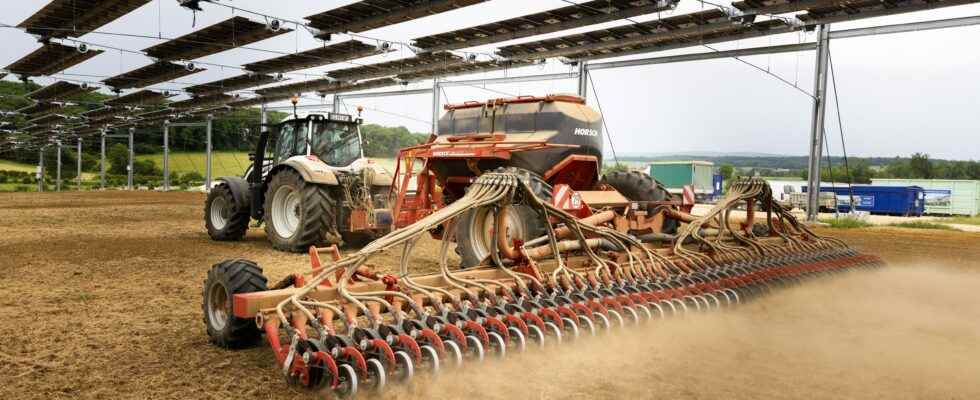At the Salon de l’Agriculture Porte de Versailles, their presence alongside the livestock and regional product stands is hardly more surprising than lay visitors. In three weeks, the EDF pavilion, that of Engie or even GRDF will be displayed proudly alongside those mounted by workers in the agricultural world. The symptom of a change of era for agriculture, called to play a growing role in the energy transition of the country, towards the low-carbon economy.
Emmanuel Macron himself recalled this a few days ago, indicating in a video patch published on social networks the need to link agriculture and energy to achieve our climate objectives. A funny reversal, for an agricultural world which, in its broad acceptance, was at the heart of the production of biomass used for millennia by Man for heating, lighting, cooking before being doubled by the trio of energies fossil (coal, oil, and gas) and fissile (nuclear).
Photovoltaic on the ground or under farmers’ sheds, production of biofuels, agrivoltaism more recently, or even methanisation… will France’s energy salvation necessarily pass through the fields? The question today agitates the French countryside. The latter did not, however, wait for the words of the tenant of the Elysée. In the rare study carried out by the administration a few years ago on this subject and relayed in July 2020 by a Senate report, it was already indicated that the agricultural sector, “with a minimum of 50,000 farms concerned”, already ensured in 2015 nearly “20% of renewable energy production”. In addition, “96% of the national production of biofuels” then returned to agriculture, “83% for wind power, 26% for biogas, 13% for solar photovoltaic and 8% for biomass heat”.
An unstoppable dynamic
And the dynamic is not about to stop. “According to the prospective scenarios of Ademe, NégaWatt or even Solagro, this production is set to grow rapidly on the horizon of carbon neutrality in 2050 – multiplied by 3, from 4.6 Mtep (megaton equivalent oil, Editor’s note) at 15.8 Mtep “-, still mentioned the report of the Senate. For Olivier Dauger, climate and energy referent of the FNSEA, the first agricultural union, this energy vocation is not a historical misinterpretation: “Agriculture has always produced energy in its history”, he explains. But he immediately added: “We are coming to a moment in history when energy sovereignty is at the forefront. It is healthy. But we must not forget food sovereignty. The first vocation of agriculture , it’s food and it must remain so”.
A warning shared quite widely, but to varying degrees. A few weeks ago, at the time of the parliamentary debates on the bill to accelerate renewable energies, which included within it devices concerning agrivoltaism – a fashionable word designating a project supposed to bring together the best of both worlds between production agriculture and energy of the photovoltaic solar type -, demonstrations in the Nièvre opposed project leaders to peasants refusing to live as “supplements to solar energy”. “We are peasants, not landscapers under the panels,” explained one of them to AFP.
On these disputes, it is not uncommon to find local activists from national organizations such as France nature environment (FNE), or the Confédération paysanne, who refuse the denaturation of the food vocation of the meadows. “We take the risk of jeopardizing food sovereignty for the benefit of energy sovereignty. All this, while it seems to us that there is potential elsewhere, on roofs, industrial wastelands. Photovoltaic on land agriculture, this should be the last resort”, explained for his part to the Express a few weeks ago Nicolas Girod, spokesman for the Peasant Confederation. Methanization projects, too, sometimes arouse the mistrust of local populations. Soil pollution, visual and olfactory impacts, criticism of the arrival of heavy-duty industrial projects… the production of energy from organic waste does not really leave people indifferent either.
Capitalization and speculation
For others, like the Young Farmers’ Union, it is not the philosophical question but the financial one that raises the question. The arrival of promoters of anaerobic digestion or solar photovoltaic projects is helping to make the sector even more capital intensive, through speculation on agricultural land for example. Renting a hectare of land for a photovoltaic project, for example, can be monetized over a year, sometimes more than 10 times more than for renting. This will make transmission to younger generations more difficult, even though half of the country’s farmers are expected to retire within 5 years. Or even create an economic gap between farmers owning their land and simple farmers renting this land.
So many challenges, some of which are not small. The profession is nevertheless convinced that by adopting a strict and reasoned framework for these different technologies, bad practices and negative externalities will disappear or be manageable. In reality, the commonly accepted feeling is that energy production in addition to agricultural production has many advantages. Agriculture, which accounts for 20% of the country’s greenhouse gas emissions, must already decarbonize all of these processes. However, low-carbon energy production for self-consumption can promote this while guaranteeing more linear prices for this industry, which has taken the full brunt of the current crisis.
In a profession where 18% of the population lives below the poverty line, the promise of income made possible by energy income can obviously be a more than welcome breath of fresh air. So that in the mouth of some, energy production is indeed that which, guaranteeing the sustainability of a farm, therefore contributes to the objective of food sovereignty of the country. It still has to materialize.
